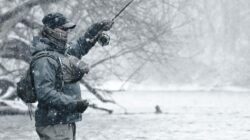Winter fishing is damn cold! Since I made a resolution to fish at least once a week, it is important to mix it up a bit. The other day, it was a wonderful, typical Montana day. A balmy 38 degrees but colder in the shade. The lower Gallatin was running cold, low, and clear.
Cold weather fishing means some preparations and considerations. Let’s start with your hands. Rub some quality hand cream into your skin. It does not hurt to coat your nose and face as well. This will help to repel the water and help with touching the line and gear. Take along some cloves as well. You need finger gloves, not mittens. Wear a full, warm glove on both hands, if possible. If not, take a warmup break periodically.
Toes require attention. Wear a polypropylene liner sock under a good pair of woolies. If your feet are to tight in the boot, you will be colder due to poor circulation. Try using a toe warmer packet. Simply open it and stick it onto the top of your toes. Carefully slide the boot over them.
Layering clothes helps keep you warm. Neoprene waders are also warmer than most other styles. A neckerchief or pull over face/neck covering helps. Most heat is lost from your toes, fingers, and head. A brimmed, warm hat tops off the perfect cold weather outfit.
Make sure that your waders are dry and without leaks. If they leak, you will be done fishing early. Traction is also more critical in the winter. Metal cleats can help but will also promote sliding. Take your time and watch where you step. Taking a river dump in the winter could be life threatening. A wading staff really helps.
Rod guides are also an issue. They tend to freeze up easily. Smear a bit of lip balm onto the small fly rod or spin rod guides. This will prevent them from icing up.
Polaroid glasses are important in winter. Light reflecting off the snow and ice can be blinding. You should always wear decent glasses when fishing. A stray hook in the eye can ruin your day. Seeing the fish clearly helps.
Fish tend to be in the tail outs during the winter, when feeding. Fish, in slow deep holes, are less active. Since the pelicans and raptors are sparse, currently, the fish also seem to be shallower. Less weight is needed, and strikes are light. Using a greased leader or strike indicator helps to see strikes.
I used a San Juan worm and a glow bug. Both produced fish steadily. A streamer had some follows but no takes. None of the fish I caught were over 16 inches, but they were feisty.
I fished twice this week!
Montana Grant
For more Montana Grant, find him shivering at www.montanagrantfishing.com.